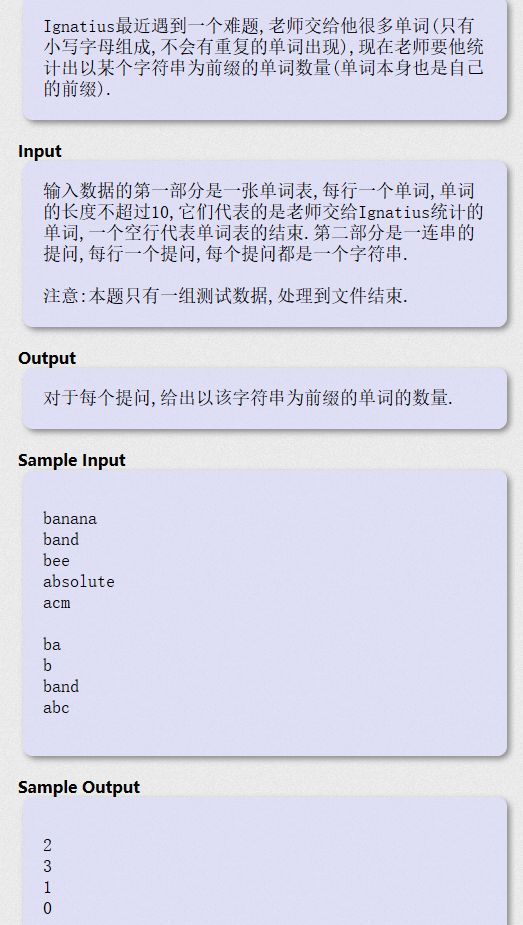字典树(trie):或名前缀树,哈希树的变种,大多题目(非水题)与哈希树套用求解。矮+胖为其显著特征,以空间换时间的典例。
通过利用字符串的公共前缀可实现字符串的快速查询。
板子如下:
#include
using namespace std;
const int maxn=2e6+5;
int tot=0;
int tree[maxn][30];
int flag[maxn];
void add(char *s)
{
int len=strlen(s);
int root=0;
for(int i=0;i0)
printf("Yes\n");
else
printf("No\n");
}
}
return 0;
}
//前缀出现次数
int trie[400001][26],tot;
int sum[400001];
void add(char *s){
int root=0;
int len=strlen(s);
for(int i=0;i
例题:
A:
板子题:
#include
#include
#include
#include
using namespace std;
const int maxn=2e6+5;
int tree[maxn][30],tot=0;//26¸ö×Öĸ
bool flag[maxn];
int sum[100007];
char a[100007];
typedef long long ll;
void add(char *s)
{
int root=0,id,len=strlen(s);
for(int i=0;i
B:
思路:有趣题,可通过建双trie储存字符串拼接对比得到结果。
#include
#include
#include
#include
#include
#include
#include
#include
C:HDU-1251
思路:和A类似,板子题
#include
using namespace std;
const int maxn=2e6+5;
int tree[maxn][30],tot=0;//26¸ö×Öĸ
bool flag[maxn];
int sum[100007];
char a[100007];
typedef long long ll;
void add(char *s)
{
int root=0,id,len=strlen(s);
for(int i=0;i
D:Immediate Decodability HDU-1305
思路:字典树的第二姿势,即对前缀的查询,稍微改改板子。若有字符串作为其他字符串的前缀,即为可消除的,也就是有一个串上非末尾阶段有flag标记。
#include
#include
#include
#include
#include
#include
#include
#include
E : What Are You Talking About HDU - 1075
用map做的,这里就不开了,到时候开map的时候会拿出来写的。
F:Phone List poj-3630
在poj上6w多KB过的,学长搬过来卡内存,就不会了。
H - 全文检索 HDU - 1277
瞎搞过的,极其难看,这里就不提了。
还有几个快乐的题比如说poj的1816,很有意思。
#include
#include
#include
#include
using namespace std;
typedef long long ll;
const ll inf=0x3f3f3f3f;
const int maxn=2e6+5;
int tree[maxn][30],tot=0;
bool flag[maxn],vis[maxn];
int n,m,p[maxn];
int add(char *s) {
int root=0,id,len=strlen(s);
for(int i=0; ilen) return;
if(pos==len && flag[root]) {
vis[root]=1;
}
if(tree[root][26]) { //*
for(int j=pos; j<=len; ++j) {
fid(s,tree[root][26],j);
}
}
if(tree[root][27]) { //£¿
fid(s,tree[root][27],pos+1);
}
id=s[pos]-'a';
if(s[pos]>='a'&&s[pos]<='z'&&tree[root][id]) {
fid(s,tree[root][id],pos+1);
}
}
char tp[100];
int main()
{
int n,m;
scanf("%d%d",&n,&m);
for(int i=0;i
搞懂哈希之后会继续补的。








